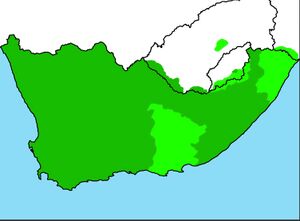Cápa
This article is a construction site. This project is currently undergoing significant construction and/or revamp. By all means, take a look around, thank you. |
| Cápa | |
|---|---|
| Cápo, Cábo, Kabo, Kabosje, isiKapa, Cape [of Good Hope] Creole | |
| isiKápa | |
| Pronunciation | [isi.kʰɐ́pɐ] |
| Created by | Jukethatbox |
| Date | 2023 |
| Setting | Cape State, Alt-history Africa |
| Ethnicity | Nguni, Caper |
| Native speakers | 14,000,000 (2023) |
Niger-Congo-Indo-European Creole
| |
Early forms | Xhosa-Portuguese
|
Dialects |
|
| Sources | Afrikaans, Portuguese, Zulu, Xhosa, English |
| Official status | |
Official language in | Cape State |
Recognised minority language in | Lesotho, Orange-Transvaal |
| Regulated by | Ministêrio iisiKápa |
Map of Cápa speakers.
Majority Cápa speaker community. Minority Cápa speaker community. | |
Cápa, also known as Cápo, Cábo, Kabo, Kabosje, isiKapa and/or Cape [of Good Hope] Creole, is an Afrikaans-Portuguese-English-Zulu-Xhosa creole language spoken in the area between the Orange River and the south African coast, commonly known as the Cape of Good Hope(cabo da boa esperança in Portuguese). The morphology is a mixture of primarily Portuguese and Dutch(later Afrikaans), whereas the grammar is heavily influenced by Zulu and Xhosa and the East Bantu language family as a whole.
The creole developed through the various colonisers of the South African region, and indeed, the language borrows elements from all the colonisers' languages(English, Dutch(Afrikaans), Portuguese) as well as native indigenous African languages in the area(Zulu, Xhosa).
Some more modern Portuguese loanwords derive from Brazilian Portuguese rather than European Portuguese, although in some cases both variations can be used, e.g. BP xícara and EP chávena, both meaning "cup", become shíxher(Cápa: [ʃík‖ʼɛɾ]), "cup" and sháfna(Cápa: [ʃɐ́ɸnɐ]), "glass(container)".
Phonology
Orthography
Cápa uses the 26 letters of the Latin alphabet, with tone, stress and length(of a sound) marked by diacritics. These diacritics are mostly based on the Portuguese alphabet, with ⟨á⟩ and ⟨à⟩ indicating rising and falling tone respectively, and ⟨â⟩ indicating high tone, ⟨ǎ⟩ indicating low tone and ⟨ā⟩ indicating a lengthened allophone.
Orthography for click consonants follows Xhosa orthographic convention for click consonants.
| Diacritics | |
|---|---|
| Length | ā · ē · ī · ō · ū |
| High | â · ê · î · ô · û |
| Low | ǎ · ě · ǐ · ǒ · ǔ |
| Rising | á · é · í · ó · ú |
| Falling | à · è · ì · ò · ù |
Consonants
Click consonants
Cápa, like its contemporary East Bantu languages, uses click consonants, however it only uses about two-thirds as many click consonants as Xhosa, with 12 in total, compared to Xhosa's 18 click consonants and Zulu's 15.
| Dental/Alveolar | Post- alveolar | |||
|---|---|---|---|---|
| central | lateral | |||
| Click | tenuis/ejective | ᵏǀʼ ⟨c⟩ | ᵏǁʼ ⟨x⟩ | ᵏǃʼ ⟨q⟩ |
| aspirated | ᵏǀʰ ⟨ch⟩ | ᵏǁʰ ⟨xh⟩ | ᵏǃʰ ⟨qh⟩ | |
| slack voice | ᶢ̥ǀʱ ⟨gc⟩ | ᶢ̥ǁʱ ⟨gx⟩ | ᶢ̥ǃʱ ⟨gq⟩ | |
| nasal | ᵑǀ ⟨nc⟩ | ᵑǁ ⟨nx⟩ | ᵑǃ ⟨nq⟩ | |
/ᵏǀʼ/ is pronounced like "tut-tut" or "tsk-tsk" in English.
/ᵏǁʼ/ is pronounced like /ᵏǀʼ/ except in the same tongue position as when you pronounce /l/.
/ᵏǃʼ/ is pronounced a bit like the sound that occurs when popping a cork from a bottle, or like /ᵏǁʼ/ but in the same tongue position as /ʃ/(sh) or /ʒ/(zh).
Vowels
Prosody
Stress
Stress in Cápa is generally paroxytonic, where primary stress is placed on the penultimate syllable of a word.
Examples
Tone
Cápa, like its contemporary languages of Zulu and Xhosa, is a tonal language, with four tones- high, low, rising and falling.
| High | Low | Falling | Rising |
|---|---|---|---|
| ˥ | ˩ | ˥˩ | ˩˥ |
Phonotactics
The general syllable structure of Cápa is (C)V(V)(C), and most words, like in Zulu, end in a vowel(with the exception of some Portuguese loanwords like shíxher).
If the dipthong ⟨ai⟩, ⟨ei⟩ or ⟨oi⟩ are succeeded by a vowel, then the /i/ is palatalised and becomes /j/.
Examples:
- /ai/ + /u/ → /aju/
- A-(negative prefix) + Iubaba(I have) → Aiubaba → Ayubaba(I do not have)
- /ei/ + /e/ → /ejè/
- Ei-(near future prefix) + Eswéla(He drinks) → Eieswéla → Eyèswéla(I will drink)
Morphophonology
Morphology
Nouns
Pronouns
Pronouns in Cápa are prefixes to verbs, similar to grammatical structure in Zulu and Xhosa. However, the pronouns themselves are mostly based on Portuguese personal pronouns.
| Person | Personal | Post-diphthong | |||
|---|---|---|---|---|---|
| Singular | Plural | Singular | Plural | ||
| 1 | Iu- | Noz- | -yu- | -yoz- | |
| 2 | Vu- | Thvu- | -fu- | -thfu- | |
| 3.M | E- | Ele- | -è- | -èli- | |
| 3.F | Sa- | Ilà- | -sà- | -là- | |
Syntax
Constituent order
Like in English, Xhosa and Zulu, Cápa uses an SVO(subject-verb-object) constituent order structure.
Noun phrase
Verb phrase
Sentence phrase
Dependent clauses
Example texts
Example sentences
- Vufawa iisiPogcugéza?
- Do you speak Portuguese?
- Hi, Ayufawa iisiPogcugéza.
- No, I do not speak Portuguese.

